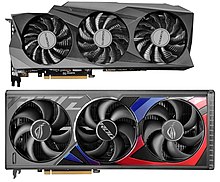
A graphics card is a computer expansion card that generates a feed of graphics output to a display device such as a monitor. Graphics cards are sometimes called discrete or dedicated graphics cards to emphasize their distinction to an integrated graphics processor on the motherboard or the central processing unit (CPU). A graphics processing unit (GPU) that performs the necessary computations is the main component in a graphics card, but the acronym "GPU" is sometimes also used to erroneously refer to the graphics card as a whole.

GeForce is a brand of graphics processing units (GPUs) designed by Nvidia and marketed for the performance market. As of the GeForce 40 series, there have been eighteen iterations of the design. In August 2017, Nvidia stated that "there are over 200 million GeForce gamers".

Alienware Corporation is an American computer hardware subsidiary brand of Dell. Their product range is dedicated to gaming computers and accessories and can be identified by their alien-themed designs. Alienware was founded in 1996 by Nelson Gonzalez and Alex Aguila. The development of the company is also associated with Frank Azor, Arthur Lewis, Joe Balerdi, and Michael S. Dell (CEO). The company's corporate headquarters is located in The Hammocks, Miami, Florida.

Quadro was Nvidia's brand for graphics cards intended for use in workstations running professional computer-aided design (CAD), computer-generated imagery (CGI), digital content creation (DCC) applications, scientific calculations and machine learning from 2000 to 2020.

In computing, CUDA is a proprietary parallel computing platform and application programming interface (API) that allows software to use certain types of graphics processing units (GPUs) for accelerated general-purpose processing, an approach called general-purpose computing on GPUs. CUDA was created by Nvidia in 2006. When it was first introduced, the name was an acronym for Compute Unified Device Architecture, but Nvidia later dropped the common use of the acronym and now rarely expands it.
EVGA Corporation is an American computer hardware company that produces motherboards, gaming laptops, power supplies, all-in-one liquid coolers, computer cases, and gaming mice. Founded on April 13, 1999, its headquarters are in Taipei, Taiwan. EVGA also produced Nvidia GPU-based video cards until 2022.

The GeForce 900 series is a family of graphics processing units developed by Nvidia, succeeding the GeForce 700 series and serving as the high-end introduction to the Maxwell microarchitecture, named after James Clerk Maxwell. They were produced with TSMC's 28 nm process.

The GeForce 10 series is a series of graphics processing units developed by Nvidia, initially based on the Pascal microarchitecture announced in March 2014. This design series succeeded the GeForce 900 series, and is succeeded by the GeForce 16 series and GeForce 20 series using the Turing microarchitecture.

NVLink is a wire-based serial multi-lane near-range communications link developed by Nvidia. Unlike PCI Express, a device can consist of multiple NVLinks, and devices use mesh networking to communicate instead of a central hub. The protocol was first announced in March 2014 and uses a proprietary high-speed signaling interconnect (NVHS).

Nvidia RTX is a professional visual computing platform created by Nvidia, primarily used in workstations for designing complex large-scale models in architecture and product design, scientific visualization, energy exploration, and film and video production, as well as being used in mainstream PCs for gaming.

The GeForce 20 series is a family of graphics processing units developed by Nvidia. Serving as the successor to the GeForce 10 series, the line started shipping on September 20, 2018, and after several editions, on July 2, 2019, the GeForce RTX Super line of cards was announced.

Turing is the codename for a graphics processing unit (GPU) microarchitecture developed by Nvidia. It is named after the prominent mathematician and computer scientist Alan Turing. The architecture was first introduced in August 2018 at SIGGRAPH 2018 in the workstation-oriented Quadro RTX cards, and one week later at Gamescom in consumer GeForce 20 series graphics cards. Building on the preliminary work of Volta, its HPC-exclusive predecessor, the Turing architecture introduces the first consumer products capable of real-time ray tracing, a longstanding goal of the computer graphics industry. Key elements include dedicated artificial intelligence processors and dedicated ray tracing processors. Turing leverages DXR, OptiX, and Vulkan for access to ray tracing. In February 2019, Nvidia released the GeForce 16 series GPUs, which utilizes the new Turing design but lacks the RT and Tensor cores.

The GeForce 16 series is a series of graphics processing units (GPUs) developed by Nvidia, based on the Turing microarchitecture, announced in February 2019. The 16 series, commercialized within the same timeframe as the 20 series, aims to cover the entry-level to mid-range market, not addressed by the latter. As a result, the media have mainly compared it to AMD's Radeon RX 500 series of GPUs.
Ampere is the codename for a graphics processing unit (GPU) microarchitecture developed by Nvidia as the successor to both the Volta and Turing architectures. It was officially announced on May 14, 2020, and is named after French mathematician and physicist André-Marie Ampère.

The GeForce 30 series is a suite of graphics processing units (GPUs) developed by Nvidia, succeeding the GeForce 20 series. The GeForce 30 series is based on the Ampere architecture, which features Nvidia's second-generation ray tracing (RT) cores and third-generation Tensor Cores. Part of the Nvidia RTX series, hardware-enabled real-time ray tracing is possible on GeForce 30 series cards.

The Radeon RX 6000 series is a series of graphics processing units developed by AMD, based on their RDNA 2 architecture. It was announced on October 28, 2020 and is the successor to the Radeon RX 5000 series. It consists of the entry-level RX 6400, mid-range RX 6500 XT, high-end RX 6600, RX 6600 XT, RX 6650 XT, RX 6700, RX 6700 XT, upper high-end RX 6750 XT, RX 6800, RX 6800 XT, and enthusiast RX 6900 XT and RX 6950 XT for desktop computers; and the RX 6600M, RX 6700M, and RX 6800M for laptops. A sub-series for mobile, Radeon RX 6000S, was announced in CES 2022, targeting thin and light laptop designs.
Ada Lovelace, also referred to simply as Lovelace, is a graphics processing unit (GPU) microarchitecture developed by Nvidia as the successor to the Ampere architecture, officially announced on September 20, 2022. It is named after the English mathematician Ada Lovelace, one of the first computer programmers. Nvidia announced the architecture along with the GeForce RTX 40 series consumer GPUs and the RTX 6000 Ada Generation workstation graphics card. The Lovelace architecture is fabricated on TSMC's custom 4N process which offers increased efficiency over the previous Samsung 8 nm and TSMC N7 processes used by Nvidia for its previous-generation Ampere architecture.
The Surface Laptop Studio 2 is a 2-in-1 convertible laptop developed by Microsoft. It was announced at a livestreamed event by the company alongside the Surface Laptop Go 3 on September 21, 2023. The device is a successor to the original Surface Laptop Studio released in 2021, and features an updated chip.

The GeForce 50 series is a series of consumer graphics processing units (GPUs) developed by Nvidia as part of its GeForce line of graphics cards, succeeding the GeForce 40 series. Announced at CES 2025, it debuted with the release of the RTX 5080 and RTX 5090 on January 30, 2025. It is based on Nvidia's Blackwell architecture featuring Nvidia RTX's fourth-generation RT cores for hardware-accelerated real-time ray tracing, and fifth-generation deep-learning-focused Tensor Cores. The GPUs are manufactured by TSMC on an improved custom 4NP process node.
















